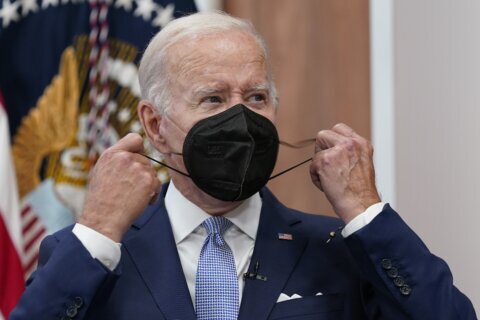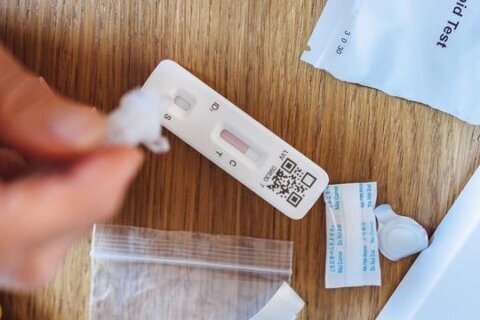When some people arrive to attend a workout class at fitness studio Cut Seven in D.C.’s Logan Circle neighborhood, sometimes they don’t bring masks.
Some non-D. C. gymgoers who come from places like Northern Virginia, which hasn’t had an indoor mask requirement since May, are sometimes unaware that mask guidelines are different across the region, Co-owner Chris Perrin said.
When they’re told masks are required during workouts, in accordance with D.C. government’s mandate, “there’s this shock of, ‘What did I just sign up for?,’” he said.
The confusion highlights the evolving conditions of the coronavirus pandemic, which has seen cities and states introduce different requirements at different times. Despite the region’s interconnectedness, officials have made autonomous decisions.
“The lack of consistency in the region, it’s a little disappointing,” Perrin told WTOP. “We would think that the leaders in the DMV would have some sort of cohesion, because we share so many of the same citizens. There’s too much confusion for folks to try to keep track of.”
That notion is in the spotlight again, as Montgomery County, Maryland, reinstituted its indoor mask mandate after seven straight days of what the Centers for Disease Control and Prevention considers “substantial” community transmission. D.C. Mayor Muriel Bowser, meanwhile, announced the city’s indoor mask requirement would end Monday, with exceptions for places like health care facilities and public transit.
Chris Beyrer, professor of epidemiology at the Johns Hopkins Bloomberg School of Public Health, said it’s best to continue wearing masks indoors, because cases are rising across the country.
“We are in a period of rising cases and rising deaths,” Beyrer said. “Now is not the time to lift mandates on many things, including indoor masking in those communities where there’s still substantial transmission. I think you’re going to see, unfortunately, a number of mask mandates come back in a number of jurisdictions. Mandates work.”
The CDC recommends even fully vaccinated people wear masks indoors in areas of substantial or high transmission. Montgomery County’s mask mandate returned after a week of “substantial” transmission, which the CDC defines as more than 50 cases per 100,000 residents. As of Sunday, D.C. recorded 730 cases per 100,000 residents, which the CDC considers high transmission.
While both jurisdictions are outpacing the national average for COVID-19 vaccination — 60.8% of D.C. residents are fully vaccinated, as are 78.4% Montgomery County residents, according to CDC data — Beyrer advises caution. With the holidays bringing people from different places together, he anticipates a rise in winter cases will prompt mask mandates in places without them to return.
At a news conference last week, Bowser said she still recommends residents take precautions like masking indoors, even without the requirement. Several council members, anticipating a holiday surge in cases, asked her to reconsider.
Montgomery County Executive Marc Elrich said he felt D.C.’s decision was “premature.” When asked, Bowser said she wasn’t familiar with Montgomery County’s plans.
Regardless of the contrasting decisions, Beyrer said, risk has to be assessed at an individual level. The best protection comes from the COVID-19 vaccines, he said, but extra precautions may need to be taken if there’s an immunocompromised person in the household, or kids younger than 5, who aren’t yet eligible to be vaccinated.
Eventually, Beyrer said, individuals will have to make decisions and calculate risk without mandates in place.
“That is eventually where we’re going to go,” Beyrer said. “We already see people talking about learning to live with COVID. I would say we’re not there yet. The reason we’re not there yet is we’re still not at 60% of everybody in this country being immunized, and we still have populations who are not eligible for vaccine.”
As of Sunday, 59.1% of the full U.S. population is fully vaccinated, and 62.8% of those 5 and older are fully vaccinated, according to CDC data.
The demand for boosters combined with oral therapeutics that have shown promising results provide reason for optimism, Beyrer said. And while mask guidance may eventually change, everyone has to evaluate their own risk, he said.
“The days where we can cough and sneeze and sit on public transportation with a bad cold and not be masked, I think that’s over,” he said.








